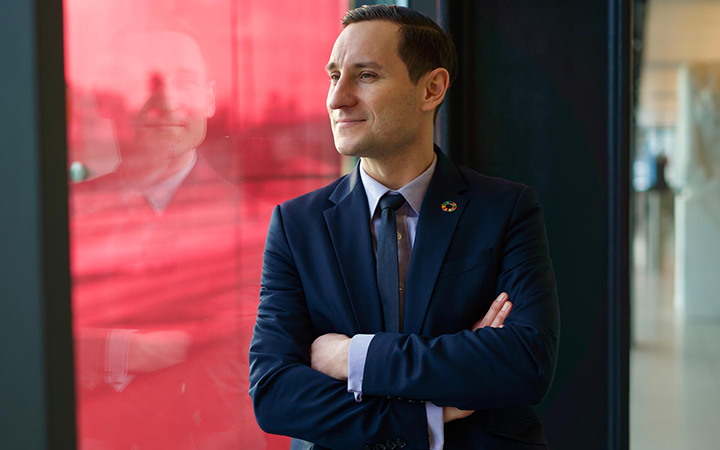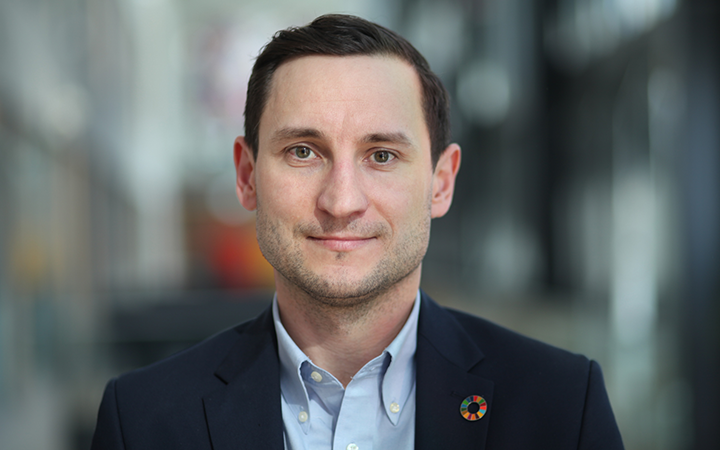Investeringar innebär en risk.
Av Natalie Westermark
You are the Head of Risk- and Ownership team, can you tell us what you work with and your responsibilities?
I lead Storebrand Asset Management’s Risk and Ownership team, with overall responsibility for screening and exclusions; pro-active and reactive dialogue with investee companies; voting at company shareholder meetings of investee companies; policy dialogue; development of Storebrand’s sustainability policies (including on human rights, nature, deforestation, and exclusions); and evaluation and selection of ESG data providers. Our team has recently grown from 5 to 10 dedicated people, spread across Oslo, Stockholm and Stavanger, and all with varied but complementary subject matter expertise within sustainability, and all with substantial experience in the field.
If we start with your background, what was it at first that made you want to work within the sustainability field?
You could say it began early: I was raised with international politics and human rights in the discussion at home growing up in Canada. My family were political refugees to Canada in the early 80’s from Soviet-governed Poland, because of my father’s involvement in the leadership of Solidarity / Solidarność” (at the time an underground social and workers’ rights movement).
“…. I was raised with international politics and human rights in the discussion at home growing up in Canada. My family were political refugees to Canada in the early 80’s from Soviet-governed Poland…”
Later on, when I was at the University of Calgary, I was active in multistakeholder discussions around “CSR” (the hot topic at that time) and was outspoken on the role of Canadian oil companies abroad (many headquartered in Calgary). After some of years studying and working in Taiwan, India, and Poland, I decided to pursue my interest in what was then known as “CSR” (Corporate Social Responsibility) and human rights in the field of international law, and tried to find some graduate programs where I could specialize in this. The Faculty of Law at the University of Oslo was one of few universities (at that time) where this was possible.
My interests quickly focused on International Law, Human Rights Law, and investment – and the newly established Ethical Guidelines for the Norwegian Wealth Fund (Oil fund). A summer internship at the Norwegian Ministry of Finance investigating companies involved in human rights violations ended with the “Oil Fund” excluding Wal-Mart, and a human rights analyst position at the Council on Ethics. I have stayed in this field of responsible investment since then, including ten years heading environmental and social due diligence for the Norwegian Export Credit Agency. In all that time, I have seen it grow in the last 20 years from a niche “Norwegian thing” to a standard practice globally.
“…. I have seen it (responsible investment) grow in the last 20 years from a niche “Norwegian thing” to a standard practice globally…”

Can you tell me more about your growing team?
In an environment where we see some scaling back on sustainability, we are doing the opposite. We have recently increased our team with five additional analysts.
Two of them, Sondre Myge and Karoline Hatlestad, are both experienced sustainability professionals that joined our team as part of the formal merger between Storebrand AM and SKAGEN. Both have a solid track record and expertise in sustainability within their work at SKAGEN, not least when it comes to ESG integration and bridging the gap between company level ESG analysis and investment decisions taken by portfolio managers. Their background and experience will both increase and complement the expertise of the team.
Our new ESG Data Analyst, Daniel Stensrud Olderkjær, will fill a vital role in the team with respect to ESG data analytics and integration into portfolio management, as well as application of ESG data into screening and exclusions.
In Sweden, we have two new members of our team. Georg Präauer, our new Senior Sustainability analyst, comes from many years of experience as an engagement specialist within ISS and will be reinforcing our work with active ownership and dialogue with companies on a broad range of topics, including climate and labour rights. Our new Corporate Governance Analyst Erik Högberg, who will also be based in our Stockholm office, will be taking overall responsibility for our voting activities, as well complementing the team with his subject matter expertise in the areas of corruption, financial crimes, and corporate structures.
The areas you work with are active ownership, exclusions and policy engagement: can you describe how you work with these issues in practice?
Active ownership means engaging with companies, including exercising our voting rights, on many sustainability topics, to enable or influence the companies we invest in, to reduce their negative impact on climate or society.
Engagement with companies can basically be divided between reactive and proactive engagements. A proactive engagement has to do with bringing a company’s attention to sustainability risks that may develop into serious risks if not adequately addressed and/or which may take time to make the necessary internal changes to address; such as living wages in supply chains for cocoa and coffee production in West Africa, transitioning away from carbon intensive operations, or managing in-direct commodity driven deforestation.
These engagements also need to coincide with our voting strategy, for example, consistently voting against the climate strategies of companies if they are not addressing our specific expectations as part of our engagements.
A reactive engagement is triggered when there are controversies and impacts that need immediate attention; this can for example be companies contributing to violations of humanitarian law in contexts or war or conflict such as in occupied Palestine, companies with operations in biodiverse sensitive areas such as direct deforestation in the amazon, or dams/mining projects in protected areas with impacts on nature and indigenous peoples.
Exclusion is not the objective; we want a constructive dialogue with the companies, leading to a change in their actions, so that we can thus continue to be invested. Exclusions are actions we take as a last resort.
We also conduct active ownership when voting at AGM expressing our views on certain ESG topics. If reactive engagement is not successful, we can escalate our dialogue through for example voting against company directors or co-filing shareholder resolutions when dialogue does not give the desired result, and when inaction of the company results in a breach of our Exclusion policy and standards.
Our engagement with policy makers is also important for creating an enabling environment for companies to act sustainably, whether it is the government of Brazil on deforestation, the Norwegian parliament on the issue of a moratorium on seabed mining, or in the UN as part of the Global Biodiversity Framework, representing global investors within Finance for Biodiversity.
“…. we want a constructive dialogue with the companies, leading to a change in their actions, so that we can thus continue to be invested. Exclusions are actions we take as a last resort…”
If we focus on data, to be able to value companies, we use several different systems but also have our own sustainability analysts. When does the own analysis take over after data checks, that distinguishes the in-house analytics from the data provider?
Looking at the screening and exclusion process, and taking conduct-based cases as a point of reference, one can say generally that the information that we get from the ESG data providers is information that we collect, together with input from other sources, experts, clients, etc., and where the in-house analytical work starts, rather than the data providers being the authoritative source by which screening and exclusion decisions are based on.
There are very many different ESG data providers and sources that we use, from some of the standard larger data providers that some of our institutional clients also use, to more niche data sources on specific themes, such as climate and nature lobbying, board and gender diversity, deforestation, seabed mining, conflict and high-risk human rights areas, etc.
The larger ESG data providers flag new controversies related to a company, which is an important source for triggering an analysis, but the data providers have different and not always corresponding methodologies between each other (and with our own methodology), for flagging the level of seriousness or contribution of a company to a potential violation. It is then the task of in-house subject matter experts on the R&O Team, whether it is on human rights, labour rights, biodiversity, environmental damage, financial crimes, etc., to take the information further for analysis, gather additional information to establish the facts in the case, initiate dialogue with company, assess the facts against our policy/operational criteria, and to evaluate the next steps – i.e. for engagement, escalation or exclusion.

If you look at engagement dialogues in the active ownership area, one example is Toyota, which Storebrand excluded from its investment universe after four years of dialogue, due to a lack of transparency and active lobbying against climate regulations. Do you have any processes for how long a dialogue can continue with a company, or is it on a case-by-case basis?
There is no defined standard cut-off for how long an engagement with a company lasts: it depends on many factors, such as nature of the risk at hand, the willingness or unwillingness for a company to meaningfully engage, the leverage and ability for us to escalate the dialogue to influence change, etc. Some engagements can be very short, such as in the case of a reactive dialogue where the company is involved in well documented serious violations and unwilling to address it, or it’s a matter of clarification of fact. For example - you are either producing controversial weapons or not, and you are either willing to cease/phase out that production or not. In these kinds of cases, the route from dialogue to exclusion is short.
In other cases, such as when the dialogue with a company is more proactive in nature, we are working with the objective of bringing awareness to the company, of certain risks that they are not aware of, but which we believe will soon become salient. For example, getting chemicals companies to address the systemic challenges of pervasive chemicals and avoid potential legal and regulatory liabilities.
In such cases, we are engaging to change policies, management systems, and organization within the company to address this adequately. This can take time, especially with large global companies, may involve other investors within larger investor coalitions, and may require exhausting avenues of escalation before taking a final decision.
What does the process look like for the exclusion of a company from investment by Storebrand?
What’s important to note is that the Risk and Ownership team is screening and conducting due diligence on our entire portfolio, aiming to identify companies that can potentially be in breach of our Exclusion Policy, but that different types of exclusions have different decision processes.
Take, for example, our product-based exclusions (such as controversial weapons, revenue from coal or oil sands, or tobacco cultivation and production): these are decided by the R&O team, based on revenue thresholds, and research we have from various ESG data providers. We regularly review this information to identify companies that have products in breach of our policy, verify this if there is doubt or unclarity, and issue an exclusion, as part of our quarterly exclusion process.
The R&O team does the same for exclusions related to certain business practices or activities (such as direct involvement in seabed mining, marine tailing disposal from mining, or direct deforestation through forest risk commodities like palm oil, soy, timber, or rubber).
When it comes to potential conduct-based exclusions (such as corruption & financial crimes, serious environmental damage, or serious or systematic breaches of human rights) these cases are often more complex and subjective in nature, requiring a higher level of due diligence by subject matter experts, verification of facts with third parties and external experts, and dialogue with the companies.
In such cases, there are two routes to a formal exclusion decision, depending again on the nature and facts of the case, the severity and link of violations to the company, the response from the company, and precedent of earlier exclusions taken by Storebrand.
And the other mechanism for the final decision point is?
Storebrand has a Sustainable Investment Committee, comprised of senior management from the Storebrand Group that meets once a quarter to take decisions on conduct-based exclusions that may set new precedents or can be controversial in nature. The R&O Team provides the Committee with a recommendation documenting the facts in the case, the response from the company, the expectations we have communicated to the company, an assessment of the extent to which the company is in breach of our Exclusion Policy and a recommendation from the Risk and Ownership team. These recommendations are presented with the company being anonymous, such that financial factors are not part of the consideration - rather the aim is to arrive at a decision that is based purely on the merits of the case. If the Committee decides to exclude, the exclusion applies across all portfolios as well as having implications that need to be considered throughout the Storebrand Group, including procurement, real estate, banking, etc.
Alternatively, if a case for conduct-based exclusion is clearly documented and has a clear precedent in other exclusion cases decided by the Committee, the R&O Team can make a decision to exclude. Our documented decision for exclusion is presented to the Investment Office (comprised of the CIOs and CEO of SAM). They have the ability to send the case further to the Sustainability Committee for a final decision if their view is that the case raises doubts on fact or precedence in earlier exclusions, otherwise the exclusion stands.
“…. financial factors are not part of the consideration - rather the aim is to arrive at a decision that is based purely on the merits of the case...”

With conflict rising around the world, military spending is growing. How do we work to navigate the complex issues around risk and ethics in investments related to this?
We are not opposed to investment in the defense sector, or conventional weapons for legitimate defense purposes. We do however acknowledge the risks and challenges inherent in investing in this sector, and thus have certain checks and balances to screen and evaluate defense (or defense-related companies) particularly distinguishing between controversial and conventional weapons.
Our policy is not based on so-called geopolitics but rather on International Humanitarian Law – IHL (the law of war), in which certain weapons are banned by international conventions and principles of IHL. This includes controversial weapons that, for example, by their very nature have characteristics such as: 1. inability to distinguish between combatant and civilian during and after conflict (referring to the IHL principle of distinction) – ex. nuclear weapons or cluster weapons; 2. Inability to be a proportionate action during conflict (IHL principle of proportionality) – for example nuclear weapons; 3. The effects of the weapons often persist after the end of the conflict and continue to represent a fundamental threat to the basic Human Rights of the affected populace (IHL principle of distinction and humanity) – ex. land mines.
When it comes to small arms, military contracts, and conventional weapons, we apply an additional screen to exclude these from certain selected funds, such as our Art. 9 and Swedish funds, which is a client-driven demand. All our other funds are open to investments in these, subject to checks and balances. Due diligence is done on all of these companies as well, and a company would be excluded across all funds if, for example it is determined that the company is involved in arms trade with a country under embargo by the UN or EU, or if it is delivering arms to countries where they have been used / or is high likelihood to be used against civilians.
It is however no secret that conducting due diligence on these companies does not come without challenges, not least because of the lack of verifiable information; that companies are often reluctant to engage with us, shielding themselves with confidentiality agreements that are at the nature of military contracts; and that many products (particularly within defense tech) can have dual civilian and military applications.
“… When it comes to small arms, military contracts, and conventional weapons, we apply an additional screen to exclude these from certain selected funds, such as our Art. 9 and Swedish funds, which is a client-driven demand….”
The Israeli-Palestinian conflict has raised many questions regarding investments in Israel. What is your basic idea in terms of investments there?
Our position on investments here is the same as our position on controversial weapons; this is not a question of geopolitics, but one of International Humanitarian Law. The fact is that Israeli settlements in the West Bank (including East Jerusalem and the Golan Heights) are illegal under IHL, as confirmed by rulings from the International Court of Justice in 2004 and 2024, by 5 UN Security Council resolutions, as well as by recommendations from the Norwegian Government.
Companies that contribute to the illegal occupation and sustaining the illegal settlements, and have no intention to address or cease their activities, are contributing to a breach of IHL and thus are in breach of our Exclusion Policy. Our process for evaluating these companies is the same, whether they are Israeli companies or international companies: we establish the facts and assess the level of severity of the company's contribution to violations. There are three levels of severity and contribution that we evaluate, in which companies falling in the first two levels are considered the most severe and are prioritized for engagement and potential exclusion.
“…Our process for evaluating these companies is the same, whether they are Israeli companies or international companies…”
You also meet with institutional investors in client meetings. What are typically the three most asked questions to you?
Most recently, there has been a large focus related to weapons and defense investments and of course investments related to occupied Palestine, in light of the attention to NBIM on the issue, the UN report from the Special Rapporteur, and the new list from the Office of the UN High Commissioner for Human Rights.
To begin with, clients want to understand our approach, why we have excluded certain companies and why we have not excluded others, and what our evaluation of the companies is on all of the lists from the UN and civil society organizations.
Secondly, clients are very much interested in our approach to climate and nature, our progress on our climate targets, our ambitions and strategy when it comes to biodiversity and biodiversity data.
Thirdly, and more generally, clients are increasingly wanting more granular information, insights, and understanding into our processes: how we evaluate/engage/follow-up specific companies (sometimes based on their own priorities and specific ratings from their ESG data provider), as well as more detailed information around case studies.
“…clients are increasingly wanting more granular information, insights, and understanding into our processes…”

When it comes to the environmental, social and governance (ESG) dimensions of sustainability, how important is the interaction between these, or do you think that at times one of the elements will be more important than the others?
In general, one can say that there is interrelation and interdependence between various ESG dimensions ̶ and that therefore, a holistic rather than siloed approach is warranted when analyzing a company. Governance issues are, for example, cut across all E and S themes. One cannot have an engagement with companies on controversies related to, for example, environmental damage, climate, labour rights, or corruption, without a dialogue on underlying policies, governance structures, procedures, and decision-making processes.
There are also often dilemmas that arise that may pitch ESG issues against each other, such as companies contributing to the green shift and renewable solar energy, but not adequately addressing forced labour risks in their polysilicon supply chain, or establishing on-shore winds farms as alternative sources of clean energy generation while ignoring the Free Prior Informed Consent of Indigenous Peoples on the areas proposed for operating these energy generation facilities.
That said, a company may have numerous impacts on a wide range of ESG dimensions; however, not all of these are as material or salient in nature. That is also part of the analysis that the R&O team does, identifying and prioritizing the salient risks that we want to target our engagement efforts with a company.
What kind of challenges do you expect to impact your job the most over the next year or two?
There are many challenges facing us at Storebrand AM and the sustainable investment industry in general. This includes the withdrawal of governments, and by extension companies, of their climate targets and goal of net zero by 2050; the changing geopolitical context with increased protracted conflicts around the world; a breakdown of respect for and compliance with the international legal order; growth in military spending and investment; the exponential growth of AI; as well as the current nature crisis and fact that we have entered the sixth mass extinction – a human-caused acceleration of biodiversity and species loss globally.
Another challenge is the ESG backlash, led by the world's largest economy, impacting everything from limiting ESG information investors can get from ESG data providers; to restrictions on filing ESG-related shareholder resolutions; to the withdrawal of global investors from investor cooperation and collaboration on joint dialogue with companies on critical ESG areas, such as climate, nature and human rights. This backlash also has an impact within Europe with the simplification and/or watering down (depending on whom you ask) of key sustainability regulations, such as the CSRD, and the CSDDD.
Add to these challenges the rising discontent among Gen Z around growing inequality, corruption, and lack of opportunities for decent livelihoods spreading across the world, and you have an unfortunate mix of uncertainty and unpredictability.
“…Add to these challenges the rising discontent among Gen Z around growing inequality, corruption, and lack of opportunities for decent livelihoods spreading across the world, and you have an unfortunate mix of uncertainty and unpredictability….”
And how are you preparing for them?
Storebrand and the Risk and Ownership team will prepare for this, in the capacity we can as an asset manager, by standing firm on our principled but pragmatic approach to Sustainability, based on respect for international law and legal order. It will be more important than ever that, in an environment where investors are pulling out of investor coalitions, we hold the fort and maintain high ambitions, that we continue to show leadership in the areas such as nature, human rights and conflict, and policy dialogue – and that we, with our 30 years of being a Sustainability Pioneer can be a point for reference or lighthouse for others to look to for staying the course on sustainability until this wave of backlash is over.
“…in an environment where investors are pulling out of investor coalitions, we hold the fort and maintain high ambitions…”
